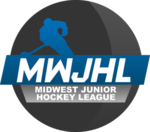Midwest Junior Hockey League
 |
|
| Sport | Ice hockey |
|---|---|
| Founded | 2012 |
| Ceased | 2015 |
| Country |
|
| Official website | Official website |
The Midwest Junior Hockey League (MWJHL) was an American junior ice hockey league. The MWJHL were members of the United Hockey Union and sanctioned by the Amateur Athletic Union (AAU). On March 10, 2015, the league announced it would be joining the United States Premier Hockey League as part of a new Midwest Division beginning in the 2015–16 season.
The MWJHL began in 2012 with a league office in Sylvania, Ohio consisting of six full-time employees to support members vision and objectives. The first league meetings were in July 2012 in Deerfield, Illinois, to establish the first member teams, conference alignment of the teams, and playoff format. On July 18, 2012 The MWJHL announced that Kevin Shanahan was named as the director of hockey operations. As the league continued to form, the MWJHL named Patrick Pylypuik president and chief executive officer for the 2012–13 season. He had previously been serving on an interim basis. Randy Montrose of the Hartland Hounds was elected chairman of the board for the MWJHL. Keith Lang of Tennyson Chevrolet named executive vice-president. Doug Goudreau from the Soo Firehawks was named secretary/treasurer.
The league initially planned for a total of 11 teams for the inaugural season, including: Bloomington Jr. Blaze, Dayton Aeros, Great Lakes Lightning, Hartland Hounds, Holland River Bandits, Ironwood Bears, Lake Erie Steelheads, Michigan Ice Dogs, Northwest Ohio Grrrowl, Rhinelander Street Cats, Soo Firehawks, and the Tennyson Chevrolet. The teams were divided into two conferences and four divisions. The American Conference comprised the North (Rhinelander and Soo) and Central (Great Lakes, Hartland, Michigan, Tennyson) Divisions. The National Conference included the East (Dayton, Lake Erie, NWO) and West (Bloomington and Holland) Divisions. The top two teams in each division would qualify for the post-season. The first round would be a best-of-three format played at the higher seed’s rink. The second round would also be a best-of-three series with Games 1 and 2 played at the higher seed’s rink and if necessary, Game 3 would be played at the lower seed’s rink. The championship final would be a best-of-five with the first three games at the higher seed’s rink and the last two, if needed, at the lower seed’s rink.
...
Wikipedia
